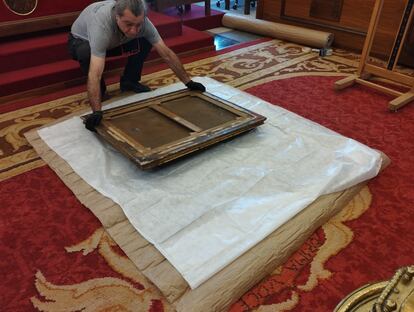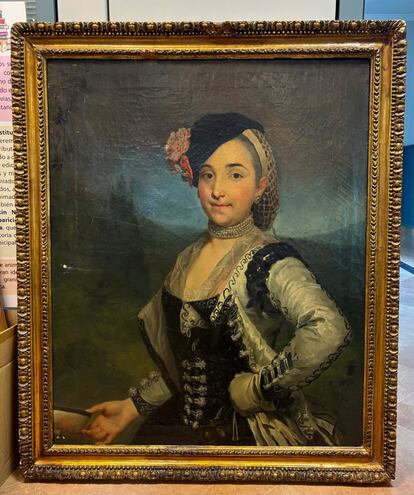A portrait of the Marchioness of Llano confiscated by the Franco rebels in 1938 from the Bilbao family of De la Sota y Llano has been returned to its rightful owners. The descendants of the owners from whom the canvas was taken have spent decades asking for its restitution, but for years the answer was always that it was “a loot of war.”
Until an official from the Culture area of the Burgos City Council, Ignacio González, took the claim seriously and found the work in a warehouse of the San Juan monastery in Burgos. After that, the procedures were completed, under the regulatory framework of the Democratic Memory Law and the will of the City Council (PP supported by Vox), which culminated this Tuesday with its formal return. Last year, the De la Sota y Llano family also achieved the restitution of two other canvases that had ended up in the state collection of Paradores, which represented a precedent in the current legal system for subsequent claims.
The portrait of the Marchioness of Llano, by the painter Anton Raphael Mengs, will soon be exhibited at the Museum of Fine Arts in Bilbao. The return ceremony was held at the Burgos City Hall with the presence of the mayor, Cristina Ayala (PP), Ramón de la Sota and the official Ignacio González. The councilor has highlighted the “pleasure and personal satisfaction” that comes with repairing a debt “maintained for more than half a century” with the Bilbao family. Tomás de la Sota thanked the City Council for its diligence and González’s effectiveness: “Without his efforts to search we would never have found this painting,” De la Sota highlighted next to the painting, which is in good condition except for some scratches on the frame and slight scratches on the canvas. The technicians at the Bilbao Fine Arts Museum will thoroughly evaluate it before exposing it to the public.
The history of this 19th century portrait took a turn in 1938. Patricia Fernández, lawyer at the Ramón y Cajal law firm, representative of the family, explains that the legacy of the shipping businessman Ramón de la Sota, linked to Basque nationalism, was apprehended by the Francoist uprisings, who also took over the Ibaigane palace in Bilbao, then the family residence and today the headquarters of the Athletic Club of Bilbao. There they seized multiple artistic pieces from various authors, many of them local, which were documented in minutes from 1938 where it was specified which furniture, lamps or paintings had been taken and what their fate would be.
In the case of De la Sota, many of the works ended up in Burgos. Fernández details that some were destined for the Isla Palace, headquarters and one of Franco’s residences during the Civil War, in addition to other buildings taken by the rebels. Once the war was over, claims for the looted works began, supported by all kinds of evidence, such as the writings of Franco’s minister Ramón Serrano Suñer, critical of his counterpart Juan Antonio Suanzes, whom he reproached for having an office full of works derived from that looting. to members of the republican side or ideological enemies such as regional nationalists.

The first attempts to return them failed with the argument that they were “war booty” and should not move from the walls of the ministries they decorated. In 1969, faced with the initial amnesties, the descendants insisted and had judicial support, but there was no political will for restitution. In 1975 the then Burgos City Council collaborated but they did not find the painting.
That is until 2023, when a new effort began to bear results. To do this, they provided photos of each copy, as there is one in the Royal Academy of Fine Arts of San Fernando (Madrid) and in the Rijksmuseum in Amsterdam (Holland). These images awakened the artistic nose of Ignacio González, an official who knows the works of art related to the City Council. The man from Burgos smiles when he remembers how his mind was enlightened thanks to those photographs: in 2013 he had located the heritage file for a painting like those, although incorrectly identified, which indicated that it was kept in the monastery of San Juan de Burgos. Where he was before he ended up there is a mystery. “It appeared that he had received it from the Mayor’s Office. I imagine that he would be in some office, someone didn’t like him and he was kept in the monastery,” González recalls.
The now owner of the painting and the Ramón y Cajal law firm have relied on the Law of Historical and Democratic Memory, which facilitates the return of the heritage plundered during the Franco regime to its original owners. Cristina Ayala has downplayed the national regulations, has alluded to “political will, common sense and justice” and has highlighted the corporation’s commitment: “Laws are not necessary for this, for me as mayor of the PP it is a reparation for something that was done wrong, such as seizing works from a private businessman. The City Council tries to comply with all laws. There is a legal framework, but the decision is not made by that regulatory framework.”
Patricia Fernández celebrates the “political will” of the Burgos City Council, since in similar cases it encounters resistance from administrations, from city councils to ministries. The De la Sota, like other families opposed to the Franco regime, lost a total of 169 works. Many of them are located and their recovery depends on the diligence, and desire, of the public entities where they ended up. Others remain unaccounted for.
Subscribe to continue reading
Read without limits
_

